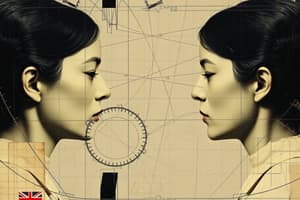Podcast
Questions and Answers
What type of fingerprint pattern has ridges that form circles or spirals?
What type of fingerprint pattern has ridges that form circles or spirals?
- Loop
- Arch
- Tented Arch
- Whorl (correct)
Which layer of hair is the thickest?
Which layer of hair is the thickest?
- Epidermis
- Cortex (correct)
- Cuticle
- Medulla
What is the minimum number of minutiae required to establish an identical fingerprint?
What is the minimum number of minutiae required to establish an identical fingerprint?
- 10
- 12 (correct)
- 14
- 8
Which type of fingerprint has a pronounced upward thrust or spike in the center?
Which type of fingerprint has a pronounced upward thrust or spike in the center?
What are independent variables in an experiment?
What are independent variables in an experiment?
What does rigor mortis indicate about a deceased person's condition?
What does rigor mortis indicate about a deceased person's condition?
Which of the following tissues is primarily responsible for contraction and movement?
Which of the following tissues is primarily responsible for contraction and movement?
How do valve defects differ from septal defects in heart conditions?
How do valve defects differ from septal defects in heart conditions?
Which brain lobe is responsible for processing auditory information and memory?
Which brain lobe is responsible for processing auditory information and memory?
Which type of tissue functions to cover and line surfaces in the body?
Which type of tissue functions to cover and line surfaces in the body?
What component of blood is responsible for carrying oxygen?
What component of blood is responsible for carrying oxygen?
What is the primary function of a confirmatory test in analysis?
What is the primary function of a confirmatory test in analysis?
Which blood type has the presence of A and B antigens?
Which blood type has the presence of A and B antigens?
How does angle of impact affect the appearance of a bloodstain?
How does angle of impact affect the appearance of a bloodstain?
What are the three components of a nucleotide?
What are the three components of a nucleotide?
What is the primary function of genes within chromosomes?
What is the primary function of genes within chromosomes?
How do prokaryotic cells differ from eukaryotic cells?
How do prokaryotic cells differ from eukaryotic cells?
What is the purpose of gel electrophoresis in DNA profiling?
What is the purpose of gel electrophoresis in DNA profiling?
During gel electrophoresis, why do smaller DNA fragments move further than larger ones?
During gel electrophoresis, why do smaller DNA fragments move further than larger ones?
Which of the following correctly defines 'Cause of Death'?
Which of the following correctly defines 'Cause of Death'?
In the context of autopsy terminology, what does 'Manner of Death' describe?
In the context of autopsy terminology, what does 'Manner of Death' describe?
Which organ is primarily associated with the Urinary System?
Which organ is primarily associated with the Urinary System?
What physiological process directly caused the body's failure, often termed as the Mechanism of Death?
What physiological process directly caused the body's failure, often termed as the Mechanism of Death?
Flashcards
Red Blood Cells (Erythrocytes)
Red Blood Cells (Erythrocytes)
Red blood cells are responsible for transporting oxygen throughout the body.
White Blood Cells (Leukocytes)
White Blood Cells (Leukocytes)
White blood cells fight infection by attacking harmful microorganisms.
Platelets (Thrombocytes)
Platelets (Thrombocytes)
Platelets help stop bleeding by forming clots at the site of injury.
Presumptive Test
Presumptive Test
Signup and view all the flashcards
Confirmatory Test
Confirmatory Test
Signup and view all the flashcards
Independent Variable
Independent Variable
Signup and view all the flashcards
Dependent Variable
Dependent Variable
Signup and view all the flashcards
Control
Control
Signup and view all the flashcards
Fingerprint Minutiae
Fingerprint Minutiae
Signup and view all the flashcards
Cuticle
Cuticle
Signup and view all the flashcards
Rigor Mortis
Rigor Mortis
Signup and view all the flashcards
Algor Mortis
Algor Mortis
Signup and view all the flashcards
Livor Mortis
Livor Mortis
Signup and view all the flashcards
Brain Lobes
Brain Lobes
Signup and view all the flashcards
TBI vs CTE
TBI vs CTE
Signup and view all the flashcards
What is a Gene?
What is a Gene?
Signup and view all the flashcards
What is a Chromosome?
What is a Chromosome?
Signup and view all the flashcards
What is DNA?
What is DNA?
Signup and view all the flashcards
What is a Eukaryotic cell?
What is a Eukaryotic cell?
Signup and view all the flashcards
What is a Prokaryotic cell?
What is a Prokaryotic cell?
Signup and view all the flashcards
What is the Cause of Death?
What is the Cause of Death?
Signup and view all the flashcards
What is the Manner of Death?
What is the Manner of Death?
Signup and view all the flashcards
What is Mechanism of Death?
What is Mechanism of Death?
Signup and view all the flashcards
Study Notes
Polygraph
- Polygraph tests measure physiological responses to detect deception
- Physiological responses include heartbeat rate and breathing speed
- Polygraph tests are used to detect if a person is lying or not
- Baselines are established to determine a person's normal range of heartbeat or intervals
- Polygraph tests are not 100% reliable
Experimental Design
- Testable hypothesis: Salt dissolves in hot water faster than sugar
- Independent variable: the variable changed to affect the results
- Dependent variable: the variable being measured in an experiment
- Control variable: A dependent variable that is not affected by the independent variable
- It acts as a baseline
Hair Structure
- Cuticle: Outermost layer of hair, made of overlapping dead cells
- Cortex: Middle layer of hair, thickest layer
- Both these layers play a critical role in protecting and maintaining the structural integrity of the hair shaft.
Fingerprints
- Arch: Ridges flow from one side to the other, least common
- Tented Arch: Similar to arches but with a more pronounced spike
- Loop: Ridges flow in one side, recurve, and exit on the same side (radial or ulnar)
- Whorl: Ridges form circles or spirals, classified as plain, central pocket, double loop, or accidental
- Minutiae: Tiny details in fingerprints that make them unique
- Identical fingerprint matching requires 12 minutiae matches
Blood Components
- Red blood cells (erythrocytes): Carry oxygen
- White blood cells (leukocytes): Fight infection
- Platelets (thrombocytes): Help with blood clotting
- Plasma: Liquid component carrying other blood cells and substances
Blood Types
- Antigens: Molecules on blood cells triggering immune response
- Blood types (A, B, AB, O) are determined by specific antigens present
Blood Spatter Analysis
- Blood droplet size is affected by drop height and angle
- Steeper drop angle creates elongated blood spatters
- 90-degree angle creates circular blood spatters
Nucleotide Structure
- Nucleotide components: Nitrogenous base, pentose sugar, phosphate group
DNA Base Pairing
- A pairs with T
- G pairs with C
DNA Structure and Function
- Deoxyribose sugar
- Nitrogen bases
- Nucleotides
- Phosphate group
- Genes: Specific segments of DNA
- Chromosomes: DNA structures inside the nucleus
- Genes are the functional units of heredity located on chromosomes
Prokaryotic vs Eukaryotic Cells
- Prokaryotic: No Nucleus
- Eukaryotic: Has a Nucleus
DNA Analysis/Profiling
- PCR amplifies small amounts of DNA
- Restriction enzymes cut DNA at specific sites creating unique fragment lengths
- Gel electrophoresis separates fragments by size to visualize a DNA profile
Autopsy
- Cause of death: The specific injury or disease that initiated the death sequence.
- Manner of death: How the death occurred (e.g., homicide, suicide, accidental)
- Mechanism of death: The physiological process that directly caused the body to stop functioning.
Body Systems
- Organs matched with their respective systems (e.g., Heart–Cardiovascular).
Time of Death
- Livor mortis, rigor mortis, algor mortis, insect activity
- These factors can help estimate the time of death
Levels of Organization
- Cell, Tissue, Organ, Organ System (e.g., Muscle tissue, Stomach, respiratory system, etc.) -
Brain Lobes
- Frontal lobe: Planning, decision making
- Parietal lobe: Sensory information (touch, taste)
- Temporal lobe: Auditory information, memory
- Occipital lobe: Visual information
TBI vs CTE
- TBI: Single blow to the head
- CTE: Multiple blows or repeated head trauma
- Effects of CTE generally worse than TBI
Heart Defects
- Valve defects: Valves do not open or close properly
- Septal defects: Hole in the heart wall
Studying That Suits You
Use AI to generate personalized quizzes and flashcards to suit your learning preferences.




